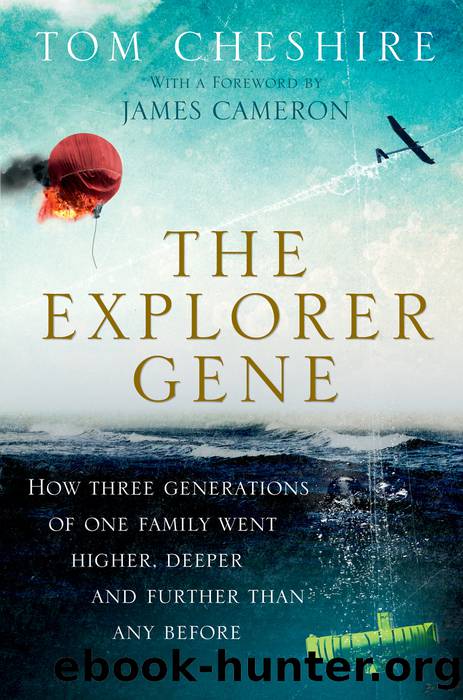The Explorer Gene by Tom Cheshire

Author:Tom Cheshire
Language: eng
Format: epub
ISBN: 9781476730288
Publisher: Atria Books/Marble Arch Press
The Trieste is lowered into the water
The dives proved useful scientifically, too: âOn every dive there was a biological wealth. The 700-fathoms bottom of the San Diego Trough was ploughed over and churned by animals, like a battlefield as seen in miniature.â The observers found ophiuroids, also known as brittle-stars, âwrithing and twisting like the snakes on Medusaâs headâ, according to Jacques; the bottom-dwellers had previously been supposed to be quiet and lethargic. Piccard and his observers made friends with black cod: âOne even tried to enter the sphere,â Jacques wrote. âWith his mouth pressed against the port, as though trying to fathom the nature of this transparent solid, he looked like a fish in a goldfish bowl. But it was I who was in the bowl. I was a captured specimen of Homo sapiens on display alive in their world.â The most scientifically productive dive was also the most dangerous, undertaken with a researcher from the NEL, who measured the velocity of sound underwater, according to certain variables. This called for a hovering dive â difficult because of the Triesteâs depth instability. âWe had just finished hovering at 85 fathoms [510 ft, 155m] and were slowing, settling deeper, when we heard a sharp implosion followed by bubbling sounds. Then a little later, a second implosion startled us. An implosion is a simple collapse of some air-filled device or component. Under the high sea pressure, this kind of collapse can be as violent as an explosion. Such implosions are disquieting, needless to say. The force could be sufficient to rupture the skin of the float with dire consequences.â Jacques continued the dive. Back in port, he found the camera fitted beneath the float had failed, causing the implosions: it was one of the few components Jacques had not designed himself. Less seriously, Dietz and Piccard put half a dozen eggs, wrapped in cotton, in a porous plastic box, strapped topside one dive. Egg shells are semiporous, allowing water to pass in and out of the egg, and thus equalise pressure inside and outside the shell; the bathyscaphists were eager to see whether the eggs would survive, as a âstriking demonstration of the principle of the Triesteâs fragile float, which also permits water to enterâ. Every egg returned to the surface intact. Less resilient was the towboat of the Trieste: one afternoon, returning to harbour, the old, leaky vessel broke down. The bathyscaphe, 600 feet behind, caught up, rode over it and smashed it to splinters, causing it to sink. âThe accident created quite a little excitement.â
The dives were successful scientifically, but Project Nekton was merely treading water before the outrageous challenge that lay ahead: Challenger Deep. âThat late summer of 1959, one could sense the increasing tension in the air. Although the fact never appeared in directive or memorandum, we all knew what we were shooting for . . .
âLogistics, procurement, tests and training all pointed to one objective. It was destination Guam, the Challenger Deep, the Big Dive.â In
Download
This site does not store any files on its server. We only index and link to content provided by other sites. Please contact the content providers to delete copyright contents if any and email us, we'll remove relevant links or contents immediately.
Hit Refresh by Satya Nadella(9001)
When Breath Becomes Air by Paul Kalanithi(8272)
The Girl Without a Voice by Casey Watson(7781)
A Court of Wings and Ruin by Sarah J. Maas(7568)
Do No Harm Stories of Life, Death and Brain Surgery by Henry Marsh(6845)
Shoe Dog by Phil Knight(5085)
Hunger by Roxane Gay(4836)
A Higher Loyalty: Truth, Lies, and Leadership by James Comey(4803)
The Rules Do Not Apply by Ariel Levy(4797)
Everything Happens for a Reason by Kate Bowler(4617)
Tuesdays with Morrie by Mitch Albom(4609)
The Immortal Life of Henrietta Lacks by Rebecca Skloot(4456)
Millionaire: The Philanderer, Gambler, and Duelist Who Invented Modern Finance by Janet Gleeson(4309)
How to Change Your Mind by Michael Pollan(4261)
All Creatures Great and Small by James Herriot(4197)
The Money Culture by Michael Lewis(4033)
Man and His Symbols by Carl Gustav Jung(4017)
Elon Musk by Ashlee Vance(3994)
Tokyo Vice: An American Reporter on the Police Beat in Japan by Jake Adelstein(3909)
